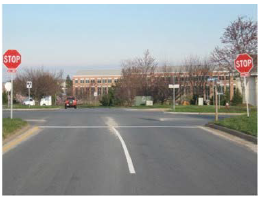Increase Visibility of Stop Signs: Double Stop Signs
Stops signs can be placed on both the right and left side of the intersection approach in order to draw attention to the signs.
Description
Stop signs can be placed on both the right and left side of the intersection approach in order to draw attention to the signs (Atkinson et al. 2014).
Placement
Atkinson et al. (2014) suggest that the second sign should be placed in the median, if possible, using a small mountable curb. Use of a second stop sign is covered in the Manual on Uniform Traffic Control Devices (MUTCD) (FHWA 2009) under Section 2A.15 Enhanced Conspicuity for Standard Signs.
Effectiveness

The MUTCD (2009) indicated a crash reduction factor of 11 percent for all crashes and 55 percent for right angle crashes with installation of double stop signs.
Advantages
- Low cost
Disadvantages
- Use of stop sign on opposing roadway could lead to confusion about travel direction for that lane
- Additional maintenance
References
Atkinson, Jennifer E., Brian E. Chandler, Vernon Betkey, Karen Weiss, Karen Dixon, Anna Giragosian, Kelly Donoughe, and Cara O’Donnell. Manual for Selecting Safety Improvements on High Risk Rural Roads. Report FHWA-SA-14-075. Federal Highway Administration, 2014.
FHWA. Two Low-Cost Safety Concepts for Two-Way STOP-Controlled, Rural Intersections on High-Speed Two-Lane, Two-Way Roadways. Publication FHWA-HRT-08-063. Federal Highway Administration, Research, Development, and Technology, McLean, VA, 2008.
FHWA. Manual on Uniform Traffic Control Devices for Streets and Highways (MUTCD). U.S. Dept. of Transportation, Federal Highway Administration, Washington, DC, 2009.

